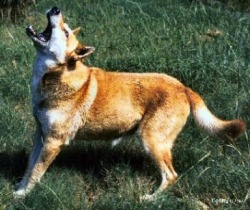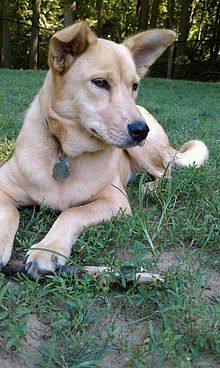Carolina
The Carolina Dog, or American Dingo, was originally a landrace or naturally selected type of dog which was discovered living as a wild dog or free roaming dog by Dr. I. Lehr Brisbin. Carolina Dogs are now bred and kept in captive collections or packs, and as pets. A breed standard has been developed by the United Kennel Club that now specifies the appearance of these dogs.[1]
Carolina Dogs were discovered during the 1970s living in isolated stretches of longleaf pines and cypress swamps in the Southeastern United States. Carolina Dogs are of medium size, with a fawn, black, white or piebald[2] coat and frequently a melanistic mask.[3]
History of the Carolina Dog
Approximately 6000 years ago, plus or minus a few thousand years, the Bible and the
Book of Mormon speak of the dispersion of the human race at Babel (later called
Babylonia) by the confusion of tongues. If this loses some of you evolutionists, I
suggest you do some research in the Old Testament and in the Book of Mormon, both
of which have millions of acceptors. From that point, the races and people eventually
got to where they were and are now. The Book of Mormon speaks of the specific
tribe of Jared and the movements there of from Babel southeastward across Asia, to
the east coast of what is probably now Mongolia, and how, contrary to evolutionary
theory, they did not cross the Bering land bridge (which may have never been a
bridge at all) but rather set sail from the east coast of Asia to the west coast of North
America. From this point they dispersed across North America, being as it stated in
the Book of Mormon, the ancestors of the American Indian. As in other migrations,
they took with them the ancestors of the Carolina dog. We do know that another
nameless tribe ended up in a different direction in Australia. The dingo arrived in
Australia at approximately the same time that the Carolina dog arrived in North
America. Neither the dingo nor the Carolina dog were native to Australia or North
America, but with the arrival of the tribes soon became widespread over both
continents.
A very important archaeological fact is that the oldest remains of the basic Carolina
dog have been discovered in the Babylonian area, which is present day Iraq. The
closest known relative to the dingo and the Carolina dog is a dog from Canaan, which
is in the Middle East, called the Canaan dog. They look almost exactly like my piebald
Carolina dogs. Now to bring this from the MIddle East to South Carolina, where the
Carolina dog was discovered to still exist, it is interesting to note why it is found
here. It isbasically found in the Savannah River site area of southern South Carolina,
across the river in Ft. Gordon GA, and along the Lynches River watershed in Lee
county, South Carolina. These areas have one unique thing in common which is that
they are fairly large uninhabited or sparsely populated areas. There are other unique
characteristics of the Carolina dog that have probably contributed to it's ability to
have maintained its special identity. You can look in the "characteristics" section of
this web page for a more detailed description of Carolina dog qualities.
The deepest penetrating road along this section of Lynches River where the dogs are
found is called Indian Springs Road which ends at the top of a hill where two springs
come together. There was an Indian village at the base of this well drained sandy
knoll, and they used the springs for their water supply. The remains of this village
were discovered by my son when he cleared the top of the knoll to build his house. It
is also interesting to note that my son's great grandmother, who was a Cherokee,
most probably lived there in the village with the ancestors of my first Carolina dog,
Tadpole. I found Tadpole as an eight week old puppy when I came upon his mother
and her puppies drinking from the spring. The puppies' mother was spooked by my
sudden appearance and ran off with the other puppies. Tadpole was left behind, and
thus started my association with the Carolina dog. It took me seven years to catch a
mate for Tadpole. After learning that the dogs that I had been seeing for almost thirty
years ( I thought they were just Lynches River wild dogs) were Carolina dogs, I made
it my goal to further study and help preserve this rare and unique animal.



There is absolutely no evidence that the Carolina dog is an indigenous land race as there has been no genetic comparative study with the archeological record. Its not a scientific statement and it may or may not be true. It also has no genetic relationship to the Dingo and most Carolina people do not appreciate the association.
ReplyDeleteRecent DNA studies by the Swedish Royal Institute of Technology confirm the probable pre-Columbian origin of the Carolina Dog. While newly-published work shows that the Australian Dingo does not belong to the dog family, I would be quite surprised if "most Carolina people" give a rodent's rear about this. http://www.nytimes.com/2013/07/16/science/a-dog-that-goes-way-back.html?pagewanted=all&_r=0
ReplyDelete